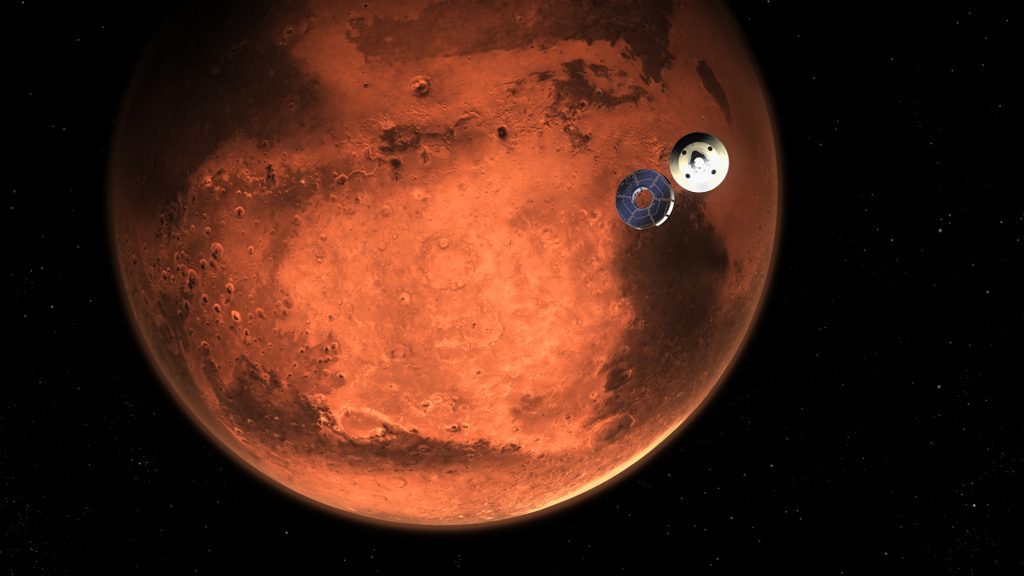
Mars
What is happening with Mars?
Hi, I’m Marley, the astronomer here at the Space Centre. Our theme this month is Mars, and as we head into the Martian winter, I wanted to check in on missions new and old – and take a look at the future.
Mars 2020
Perseverance
As of April 18th, 2022, the rover Perseverance began its second science campaign: the Delta Front Campaign. Lasting about half an Earth year, Perseverance will climb 40m up and over the delta, drilling cores along the way. The sampling will look different than in the first campaign when it was exploring the Jezero Crater floor. Instead of abrasion, proximity and remote science, and collection happening at one location all at once, Perseverance will only do the abrasion and proximity steps at up to 5 different locations during its climb. It will then descend and then collect samples. This puts information in context for scientists. Additionally, having proximity data allows scientists to pick and choose which locations are the most scientifically valuable as Perseverance only has so much space.
Once Perseverance completes its sampling and has climbed the delta, the next campaign begins the Delta Top Campaign. Until then, it climbs – and selects its own targets to zap thanks to a new software update. Read this blog post by members of the mission team to learn more!
Ingenuity
I am sorry to say that the Mars helicopter Ingenuity is having a very tough time as we move into the Martian winter. Simply put: Ingenuity was not built to last the winter. The reasons why are nicely divided into two reasons. One being the increase in dust. Ingenuity is solar-powered, and the increase in dust covers its solar array. This means that it cannot completely recharge its battery. This problem is compounded by the second reason Ingenuity is having a hard time: the winter temperatures. Many of its parts are off the shelf, meaning that they are not built to withstand overnight temperatures of -80°C. Ingenuity currently gets to about 68% charged, and it needs about 70% to keep everything powered overnight. When this is not met, the heater can no longer keep the battery and surrounding electronics warm, so Ingenuity shuts down. The rising Sun allows it to charge again, but mission specialists anticipate that the 2% deficit in charge will grow to a 7% deficit by the Martian winter solstice in July.
Currently, all of Ingenuity’s data has been sent to Perseverance, and the team is trying to get the helicopter ready to fly again. We learned on June 6th that Ingenuity’s inclinometer – a navigation sensor, has stopped working. This was a big deal, but with a software patch that tells Ingenuity to use different electronics on board, the 29th flight (out of a planned 5!) was completed on June 11th, 2022. Ingenuity may or may not make it through the winter, but it has been an extremely successful technology demonstration either way.
InSight
Where one mission makes it through the winter, another is definitely on its last legs. The NASA lander InSight is in its final stages. Launched in May 2018 with its arrival in November 2018, Insight was sent to study the interior of Mars. Studying the interior of the planet can help us better understand how the rocky planets in our Solar System formed. InSight had two large science goals: Understanding how rocky planets formed and evolved, and learning how tectonically active Mars is and how many meteorites impact the planet. It has detected more than 1300 seismic events, 50 of which had clear enough signals that the team could find out where they came from. InSight gave us the ability to further characterize the Martian crust and core. We know now that the crust is thinner than expected and is made up of three layers. For the core, it is larger than we expected – 1800km in radius, molten, and has a lower density than ours. InSight also detected thousands of passing dust devils and gave us a more comprehensive look at the weather phenomena on Mars.
The Martian weather has not been kind to InSight. Being solar-powered, it relies on its solar arrays to collect enough sunlight. Those arrays are now covered in dust. They can only produce enough energy to power an electric oven for 10 minutes. When InSight first landed, the same panels produced enough energy to power an electric oven for one hour and 40 minutes. Scientists are hoping for a breeze to clear the dust, like what happened to Spirit and Opportunity rovers, but they are preparing for the end. By the end of Earth summer, the seismometer will be turned off, concluding the science mission. After this, there will still be enough power to communicate with Earth, but by December it is anticipated that InSight will stop responding.
Martian Moons Exploration
Looking ahead, this Japanese Aerospace Exploration Agency mission aims to accomplish something that has yet to be done: exploring Phobos and Deimos, the two moons that orbit Mars. Currently, still under development, the mission is scheduled to launch in the mid-2020s. Once it arrives at the Martian system, it will enter an orbit around Phobos. Here it will observe and take a sample for return, similar to the OSIRIS-Rex mission that visited asteroid Bennu.
The main scientific goal for this mission is to offer insight on how these two moons came to be, and how the entire system evolved over time. Learning from this system will help us unlock key mysteries of planetary formation in our Solar System. We currently think that the moons have gathered sediment that has been launched from the Martian surface over billions of years from meteor impacts. Observing the moons and taking a sample can give us information on the changes the Martian surface has gone through.
If the moons were formed during collisions between Mars and asteroids, then the material gathered can take us back in time to the conditions on Mars during this period. If they are captured asteroids, then the material can help us understand how different elements and components are moved throughout solar systems, giving us ideas on how materials for life, like water, are transported. Either way – we will learn a lot about these two moons and the early Martian system, and that knowledge will give us better information for future planetary science.
Are you curious to discover more about Mars? Try out some of these activities to sate your interest in this planet.
Activities:
Time
Activity
90+ min
Driving on Mars
Follow Perseverance’s progress as it starts its second science campaign with this interactive map.
Would you make a good rover ‘driver’? Try out these rover games to find out:
Explore Mars: A Mars Rover Game (K-4)
Code a Mars Rover Driving Game (8-12)
Scientists need help to train future rovers to detect dangerous terrain and avoid getting stuck. You can help by participating in this Zooinverse project, AI4Mars.
Ask yourself: What do you think are some of the biggest challenges with ‘driving’ a rover on Mars?
60+ min
Powered by the Sun
Ingenuity and InSight both rely on solar energy to operate. Watch this short video with Bill Nye about solar-powered space travel and read this short article on how solar panels work.
Experiment with a light meter app, a smart device, a piece of clear glass or plastic, and sand to replicate what is happening the Ingenuity’s and InSight’s solar panels as they are covered with Martian dust. This article provides some options for free light meter apps. Don’t forget to protect your smart device from getting sandy!
Now build your own model of a Mars helicopter.
Ask yourself: If you were designing the next version of a Mars helicopter how would you avoid dust collecting on its solar panels?
30 min
Exploring Mars Exploration
There are currently (as of July 2022) 11 active missions on or orbiting Mars (check them out here). Read more about the two missions that arrive at Mars at the same time as Perseverance, China’s Tianwen-1 mission and the United Arab Emirates’ orbiter Hope.
The first spacecraft to reach Mars was Mariner 4 in 1965. Read more about the exciting history of Mars exploration with this article.
Ask yourself: Mars exploration is an international endeavour! Why do you think it is valuable to have many countries involved?

